Abstract
Relapse of Clostridium difficile-associated diarrhoea occurs in 15-20% of patients; however, whether relapse is due to an endogenous source of the organism or reinfection from the environment remains unclear. Restriction enzyme analysis (REA) of chromosomal DNA was used to type multiple isolates from ten patients who had experienced apparent relapses. More than half the relapses were due to infection with a new strain of C. difficile. The remaining patients were infected with the same strain, but whether this strain was acquired from the environment or from endogenous sources could not be determined. Relapses with a different strain of C. difficile could occur if an individual harboured more than one strain in their gastrointestinal tract. To investigate this possibility ten other patients were assessed for carriage of multiple strains. Ten colonies from a primary culture plate from each patient were typed by REA and tested for their ability to produce cytotoxin. All isolates from the same patient were identical by both methods, indicating that multiple carriage of strains may be a rare event.
Full text
PDF
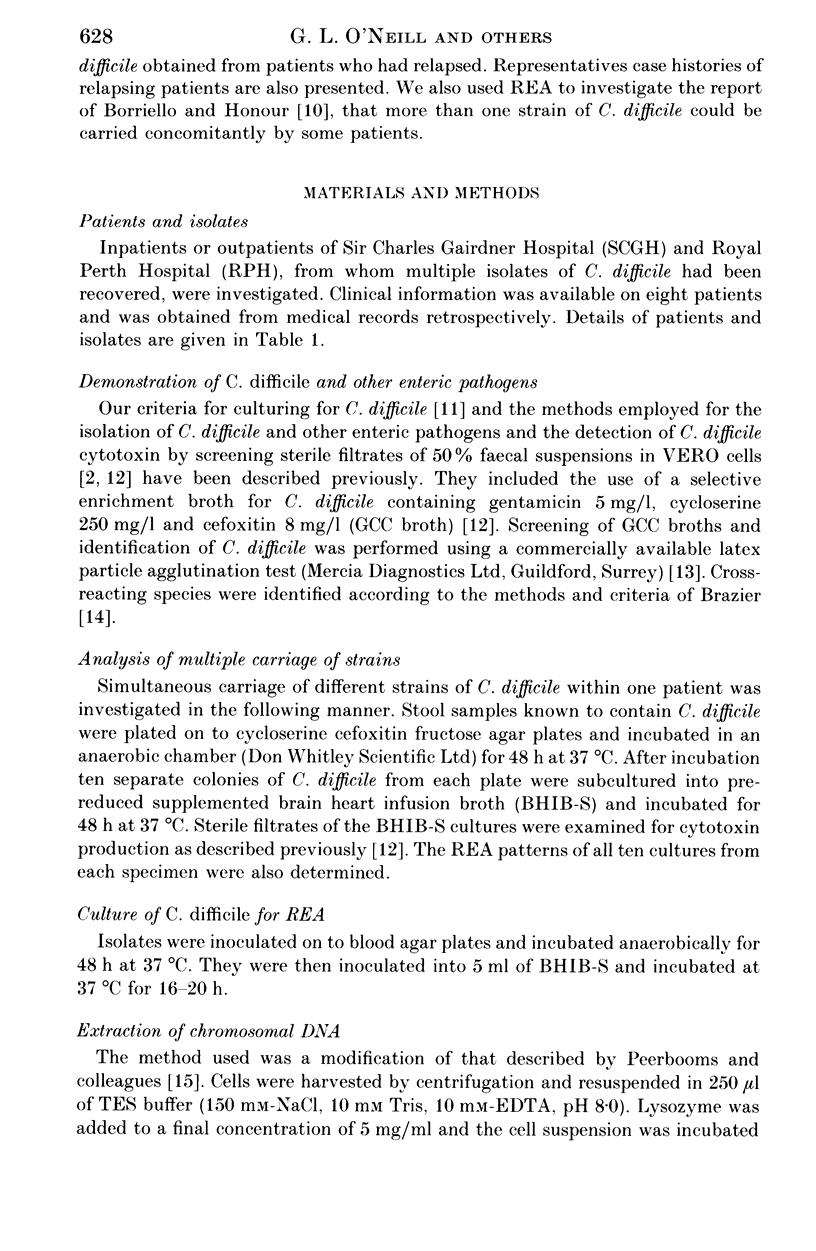
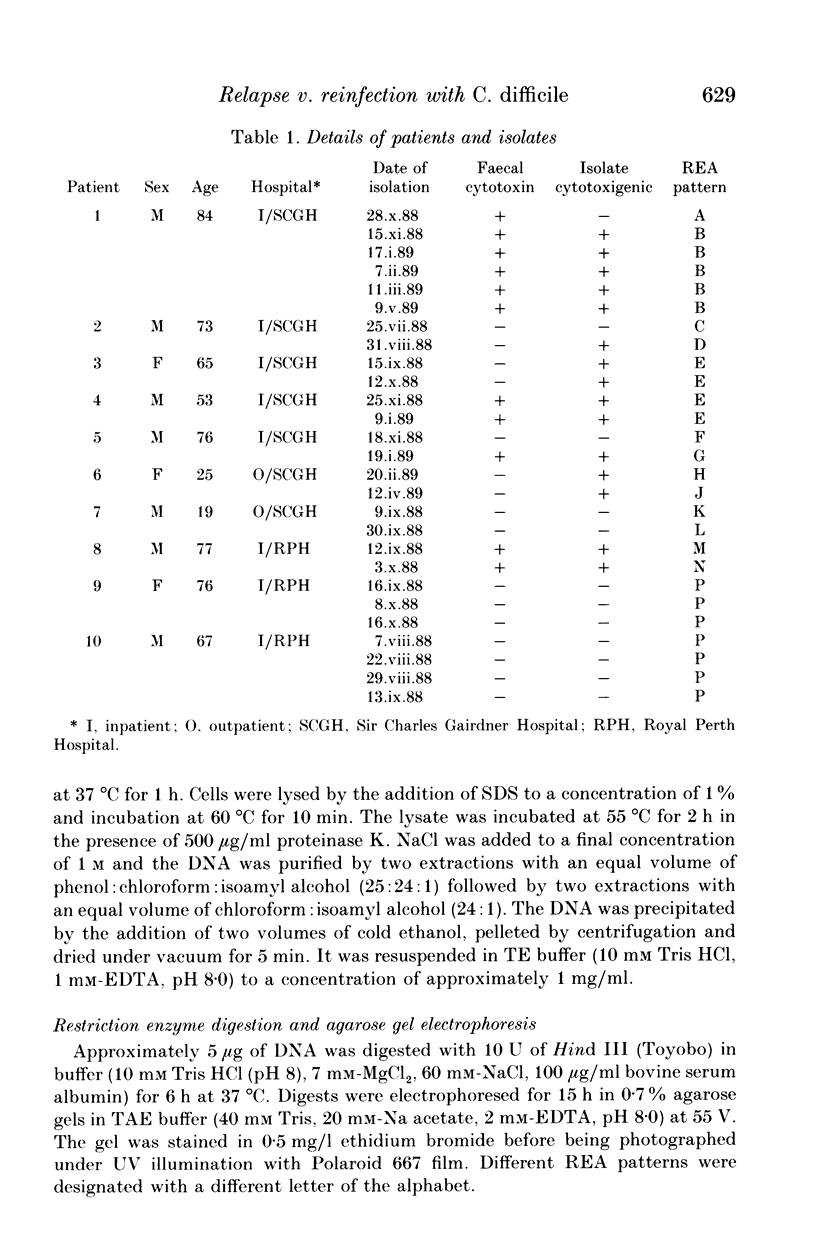
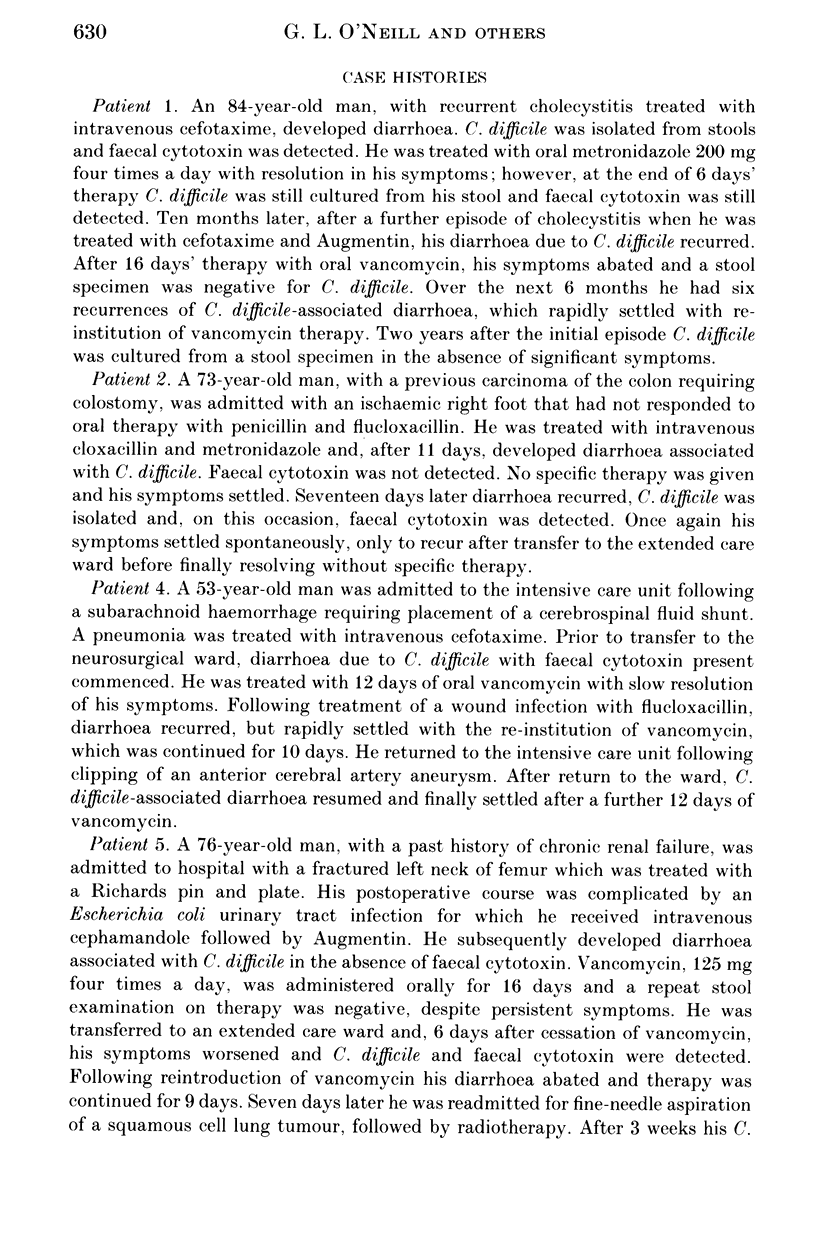
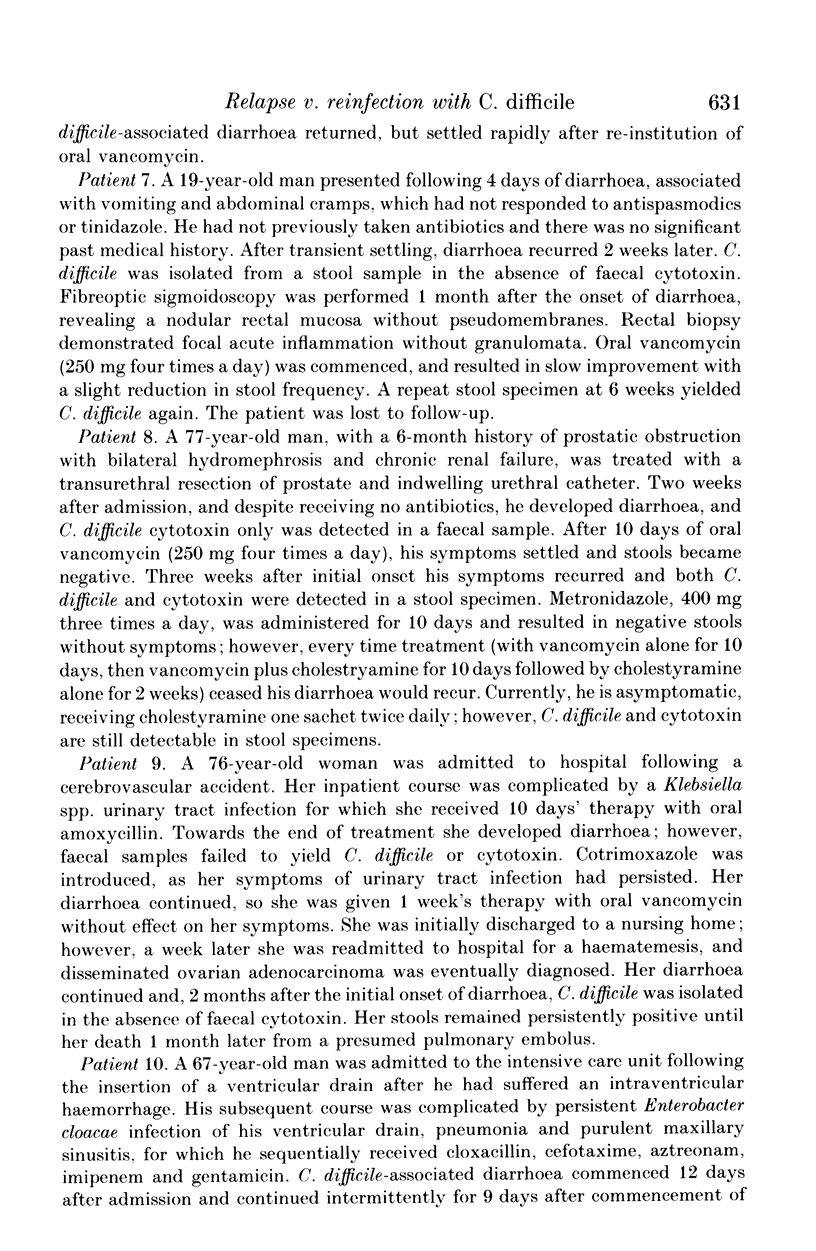
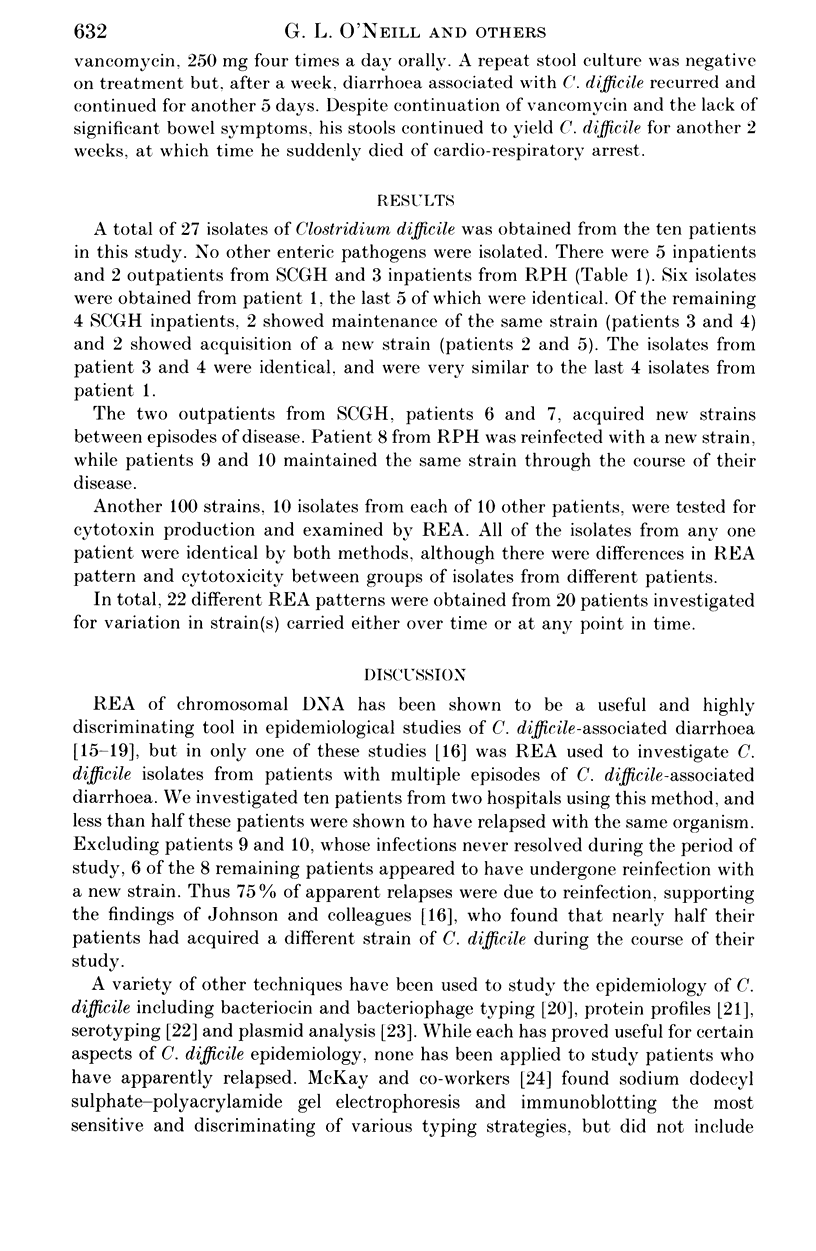
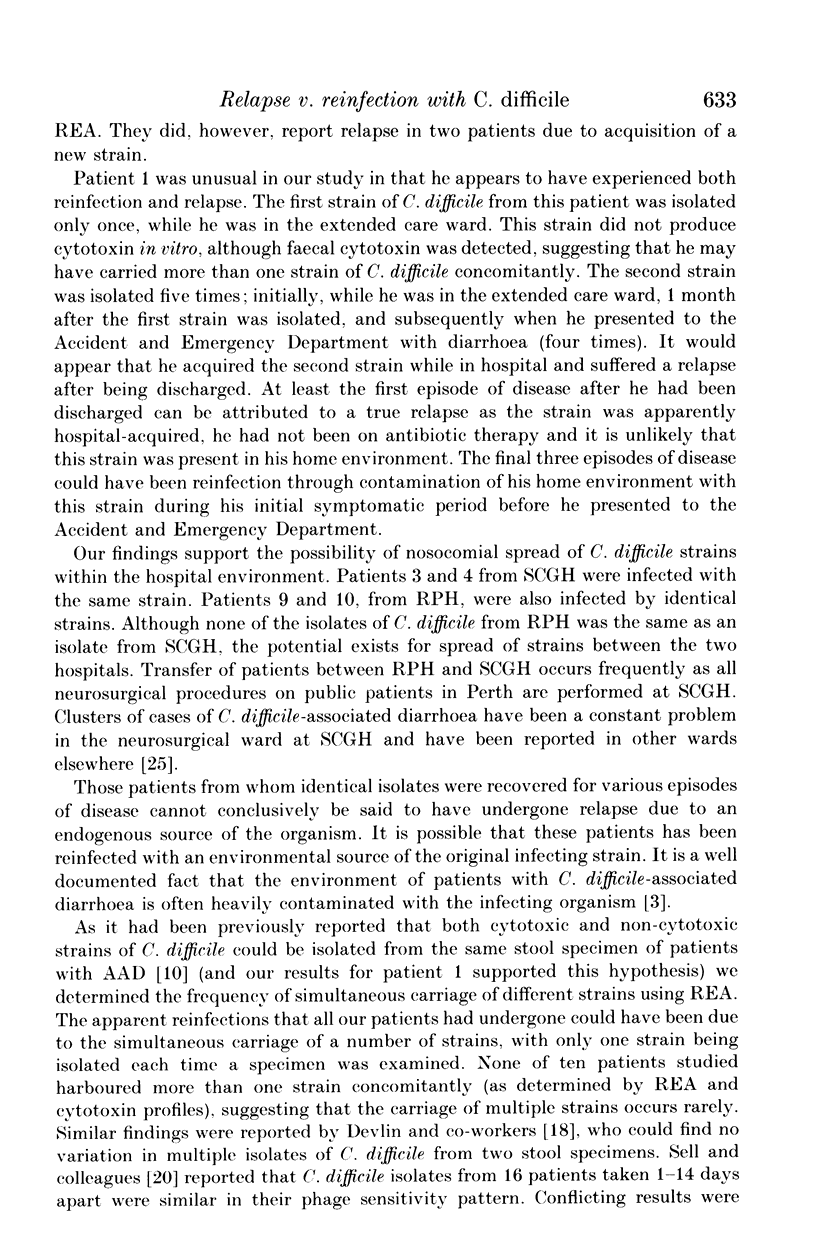

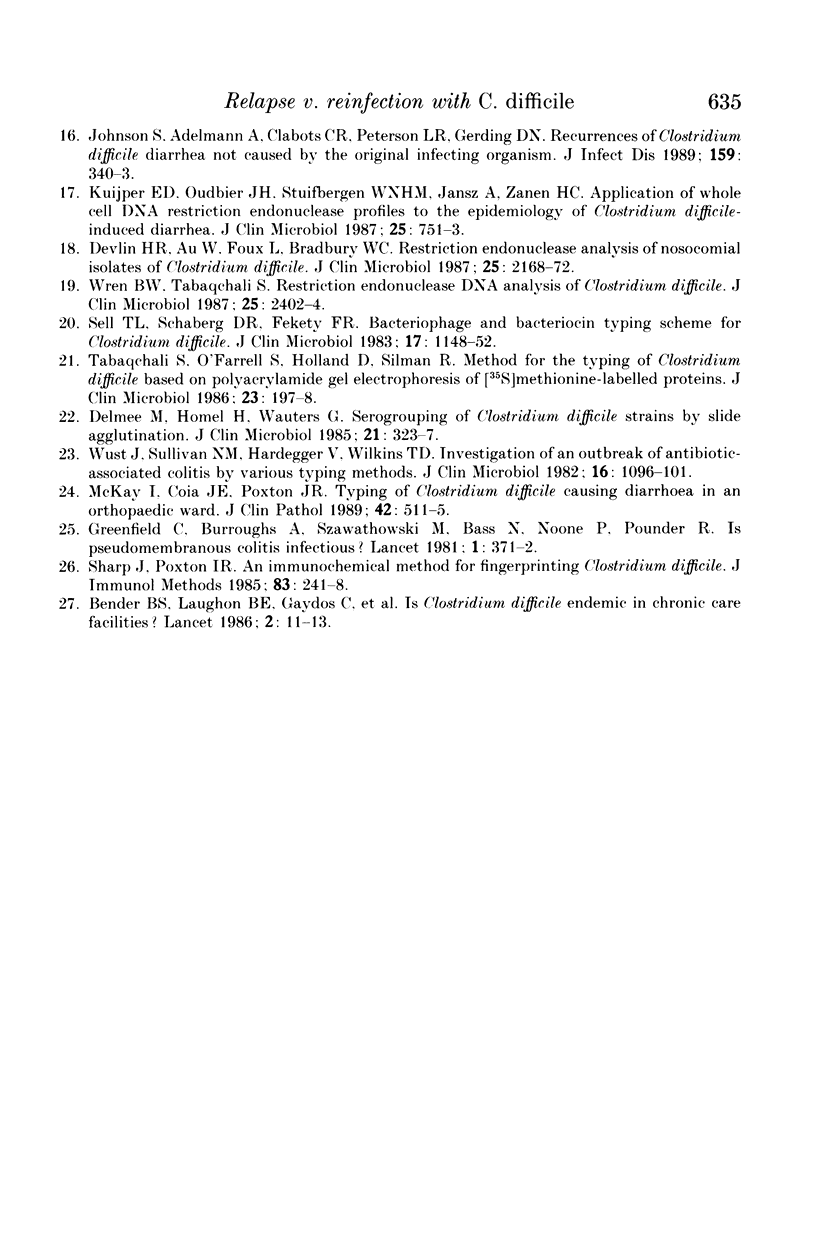
Selected References
These references are in PubMed. This may not be the complete list of references from this article.
- Bartlett J. G., Chang T. W., Gurwith M., Gorbach S. L., Onderdonk A. B. Antibiotic-associated pseudomembranous colitis due to toxin-producing clostridia. N Engl J Med. 1978 Mar 9;298(10):531–534. doi: 10.1056/NEJM197803092981003. [DOI] [PubMed] [Google Scholar]
- Bender B. S., Bennett R., Laughon B. E., Greenough W. B., 3rd, Gaydos C., Sears S. D., Forman M. S., Bartlett J. G. Is Clostridium difficile endemic in chronic-care facilities? Lancet. 1986 Jul 5;2(8497):11–13. doi: 10.1016/s0140-6736(86)92559-6. [DOI] [PubMed] [Google Scholar]
- Borriello S. P., Honour P. Concomitance of cytotoxigenic and non-cytotoxigenic Clostridium difficile in stool specimens. J Clin Microbiol. 1983 Oct;18(4):1006–1007. doi: 10.1128/jcm.18.4.1006-1007.1983. [DOI] [PMC free article] [PubMed] [Google Scholar]
- Bowman R. A., Arrow S. A., Riley T. V. Latex particle agglutination for detecting and identifying Clostridium difficile. J Clin Pathol. 1986 Feb;39(2):212–214. doi: 10.1136/jcp.39.2.212. [DOI] [PMC free article] [PubMed] [Google Scholar]
- Bowman R. A., Riley T. V. Routine culturing for Clostridium difficile? Pathology. 1984 Jul;16(3):240–242. doi: 10.3109/00313028409068530. [DOI] [PubMed] [Google Scholar]
- Carroll S. M., Bowman R. A., Riley T. V. A selective broth for Clostridium difficile. Pathology. 1983 Apr;15(2):165–167. doi: 10.3109/00313028309084706. [DOI] [PubMed] [Google Scholar]
- Delmee M., Homel M., Wauters G. Serogrouping of Clostridium difficile strains by slide agglutination. J Clin Microbiol. 1985 Mar;21(3):323–327. doi: 10.1128/jcm.21.3.323-327.1985. [DOI] [PMC free article] [PubMed] [Google Scholar]
- Delmée M., Vandercam B., Avesani V., Michaux J. L. Epidemiology and prevention of Clostridium difficile infections in a leukemia unit. Eur J Clin Microbiol. 1987 Dec;6(6):623–627. doi: 10.1007/BF02013056. [DOI] [PubMed] [Google Scholar]
- Devlin H. R., Au W., Foux L., Bradbury W. C. Restriction endonuclease analysis of nosocomial isolates of Clostridium difficile. J Clin Microbiol. 1987 Nov;25(11):2168–2172. doi: 10.1128/jcm.25.11.2168-2172.1987. [DOI] [PMC free article] [PubMed] [Google Scholar]
- Fekety R., Kim K. H., Brown D., Batts D. H., Cudmore M., Silva J., Jr Epidemiology of antibiotic-associated colitis; isolation of Clostridium difficile from the hospital environment. Am J Med. 1981 Apr;70(4):906–908. doi: 10.1016/0002-9343(81)90553-2. [DOI] [PubMed] [Google Scholar]
- Greenfield C., Burroughs A., Szawathowski M., Bass N., Noone P., Pounder R. Is pseudomembranous colitis infectious? Lancet. 1981 Feb 14;1(8216):371–372. doi: 10.1016/s0140-6736(81)91683-4. [DOI] [PubMed] [Google Scholar]
- Johnson S., Adelmann A., Clabots C. R., Peterson L. R., Gerding D. N. Recurrences of Clostridium difficile diarrhea not caused by the original infecting organism. J Infect Dis. 1989 Feb;159(2):340–343. doi: 10.1093/infdis/159.2.340. [DOI] [PubMed] [Google Scholar]
- Kuijper E. J., Oudbier J. H., Stuifbergen W. N., Jansz A., Zanen H. C. Application of whole-cell DNA restriction endonuclease profiles to the epidemiology of Clostridium difficile-induced diarrhea. J Clin Microbiol. 1987 Apr;25(4):751–753. doi: 10.1128/jcm.25.4.751-753.1987. [DOI] [PMC free article] [PubMed] [Google Scholar]
- Malamou-Ladas H., O'Farrell S., Nash J. Q., Tabaqchali S. Isolation of Clostridium difficile from patients and the environment of hospital wards. J Clin Pathol. 1983 Jan;36(1):88–92. doi: 10.1136/jcp.36.1.88. [DOI] [PMC free article] [PubMed] [Google Scholar]
- McKay I., Coia J. E., Poxton I. R. Typing of Clostridium difficile causing diarrhoea in an orthopaedic ward. J Clin Pathol. 1989 May;42(5):511–515. doi: 10.1136/jcp.42.5.511. [DOI] [PMC free article] [PubMed] [Google Scholar]
- Peerbooms P. G., Kuijt P., Maclaren D. M. Application of chromosomal restriction endonuclease digest analysis for use as typing method for Clostridium difficile. J Clin Pathol. 1987 Jul;40(7):771–776. doi: 10.1136/jcp.40.7.771. [DOI] [PMC free article] [PubMed] [Google Scholar]
- Riley T. V., Bowman R. A., Carroll S. M. Diarrhoea associated with Clostridium difficile in a hospital population. Med J Aust. 1983 Feb 19;1(4):166–169. doi: 10.5694/j.1326-5377.1983.tb104346.x. [DOI] [PubMed] [Google Scholar]
- Riley T. V., Wymer V., Bamford V. W., Bowman R. A. Clostridium difficile in general practice and community health. J Hyg (Lond) 1986 Feb;96(1):13–17. doi: 10.1017/s0022172400062483. [DOI] [PMC free article] [PubMed] [Google Scholar]
- Sell T. L., Schaberg D. R., Fekety F. R. Bacteriophage and bacteriocin typing scheme for Clostridium difficile. J Clin Microbiol. 1983 Jun;17(6):1148–1152. doi: 10.1128/jcm.17.6.1148-1152.1983. [DOI] [PMC free article] [PubMed] [Google Scholar]
- Sharp J., Poxton I. R. An immunochemical method for fingerprinting Clostridium difficile. J Immunol Methods. 1985 Nov 7;83(2):241–248. doi: 10.1016/0022-1759(85)90246-7. [DOI] [PubMed] [Google Scholar]
- Walters B. A., Roberts R., Stafford R., Seneviratne E. Relapse of antibiotic associated colitis: endogenous persistence of Clostridium difficile during vancomycin therapy. Gut. 1983 Mar;24(3):206–212. doi: 10.1136/gut.24.3.206. [DOI] [PMC free article] [PubMed] [Google Scholar]
- Walters B. A., Stafford R., Roberts R. K., Seneviratne E. Contamination and crossinfection with Clostridium difficile in an intensive care unit. Aust N Z J Med. 1982 Jun;12(3):255–258. doi: 10.1111/j.1445-5994.1982.tb02471.x. [DOI] [PubMed] [Google Scholar]
- Wüst J., Sullivan N. M., Hardegger U., Wilkins T. D. Investigation of an outbreak of antibiotic-associated colitis by various typing methods. J Clin Microbiol. 1982 Dec;16(6):1096–1101. doi: 10.1128/jcm.16.6.1096-1101.1982. [DOI] [PMC free article] [PubMed] [Google Scholar]


